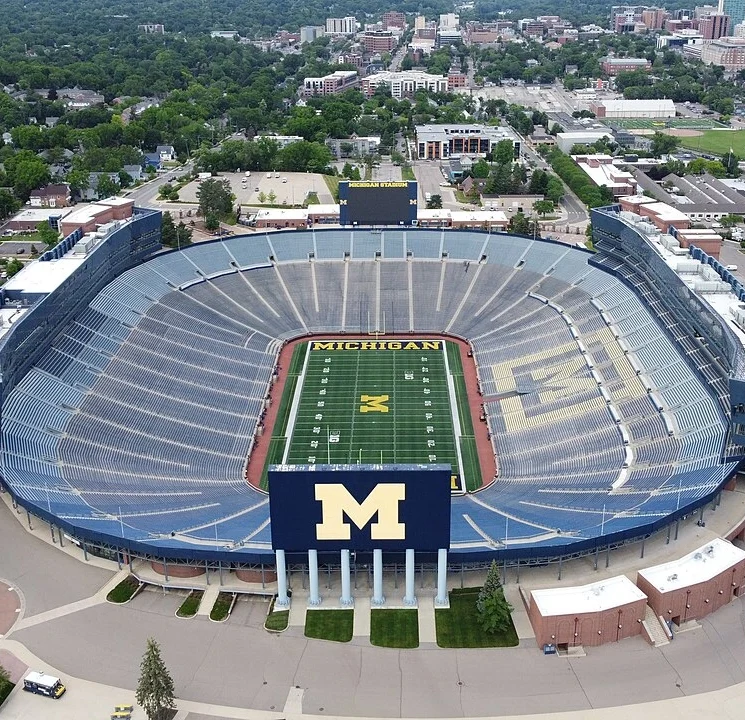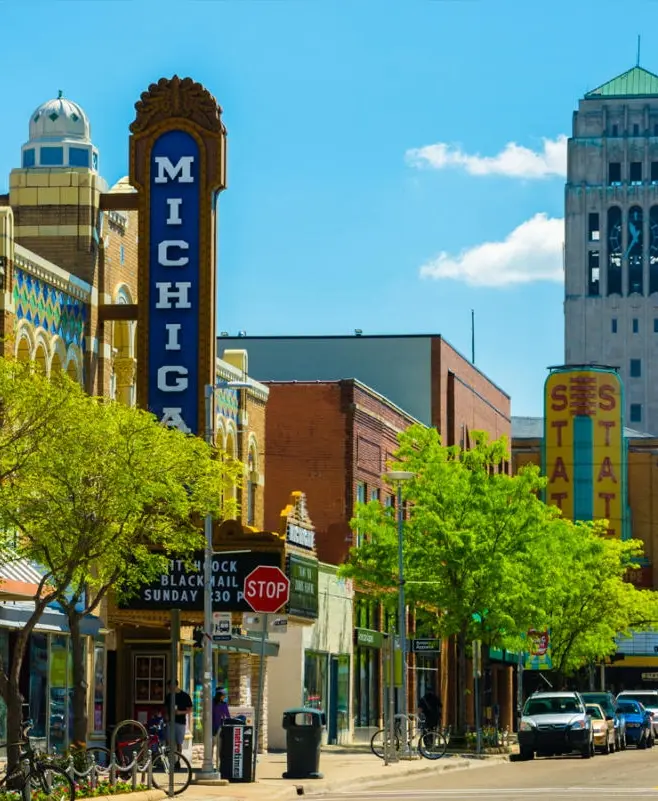Michigan Stadium
The Big House Entertainment Guide
This site is not sponsored by or affiliated with University of Michigan or Michigan Stadium. This site links to authentic resale tickets for all events at the Michigan Stadium. Please view the Disclaimer page.

Michigan Stadium
The Michigan Stadium a.k.a “The Big House” is the largest stadium in the US and the second largest stadium in the world. Home to the legendary Wolverines. Attending a game at the Michigan Stadium is at the top of every college football fans’ bucket list. This mammoth venue serves the University of Michigan in Ann Arbor. It seats a jaw-dropping 110,000 people and has hosted the lion’s share of big football games.
The old expression, “Go big or go home”, takes on a whole new meaning when it comes to Michigan Stadium. It’s affectionately referred to as “The Big House” for a reason. Michigan Stadium is the largest venue of its kind in the United States and the third largest in the world, and it is located at 1201 South Main Street, Ann Arbor, Michigan.
Michigan Stadium has often taken the lead in stadium technology. It was the first venue to use electronic scoreboards in 1930 and is one of the few college stadiums today with video scoreboards in each end zone. It still holds the NCAA (National Collegiate Athletic Association) single-season average home attendance record at 112,252 fans per game, set in 2012.
The Michigan Wolverines Football team has a local fanbase whose loyalty to the team is arguably about as ferocious as the team’s namesake. And while you may not find real wolverines in Michigan, the tenacious fans certainly make up for that.
One of the most intriguing facts about the Stadium is the mysterious “extra” seat attributed to former head coach and athletics director Fritz Crisler. The tradition was started by another former coach, Fielding Yost. During each home game, Michigan reserves a single seat for Crisler, and all Michigan Stadium capacity figures always end with the number 1. Good luck finding this mystery seat, though. Its location has always remained a closely guarded secret.
Legend has it that beneath the iconic stadium’s surface; a crane lies buried following an incident during the Stadium’s construction in the 1920s. Before the Stadium was built, the land contained a spring that provided water to the university. During construction, the land had to be lowered to compensate for the quick-sand-like soil caused by the underground lake, which consumed the crane. You may want to ask the locals about how much truth there is to this old legend.
Attending any event at Michigan Stadium is a unique and unforgettable experience. The rich history surrounding the venue and its position as one of the most innovative venues in the U.S.A. make it worth a visit – no matter what your reasons are for heading to the Great Lake State – and you’re unlikely to run out of things to do in the area around the Stadium either. If immersing yourself in the Game Day atmosphere is your thing, the electrifying vibe and epic sound system at Michigan Stadium is tough to beat.


Michigan Wolverines Football
The Michigan Wolverines are one of the oldest teams in intercollegiate football. The program began competing in 1879 and later joined the Big Ten Conference at its inception in 1896. The team has been a member of the conference for nearly its entire existence except for a short 9-year stint from 1907 to 1916. The team has a proud history of success winning or sharing 42 league titles and finishing in the top 10 of the AP Poll 38 times since 1936. The Wolverines have claimed 11 national championships, with their most recent success coming in 1997 when they were on top of the final AP poll.
But on-field success isn’t all the team has known for as it draws in and produces some of the strongest and most celebrated players and coaches in NCAA history. From 1900 to 1989, the program was led by nine head coaches who were all inducted into the College Football Hall of Fame, either as coaches or players. This includes Fielding H. Yost who became Michigan’s head coach in 1901 and guided his squads to an incredible 56 game undefeated streak from his arrival until the 1905 season finale, including a 1902 Rose Bowl win. Fritz Crisler, who coached the1947 Wolverines, led the team to a national title and Michigan’s second Rose Bowl win. Bo Schembechler coached the team for 21 seasons from 69 to 89 and led the team to 13 Big Ten titles and 194 games, a record for the program.


Ultimate Ann Arbor Entertainment Guide
If you are thinking of turning a trip to Michigan Stadium into a longer stay in the Ann Arbor area, then you will need to know the best places to eat, sleep, and have some fun!
Whether you’re heading to Michigan Stadium to watch a Michigan Wolverines game or a concert, the venue promises the kind of energy only Ann Arbor can deliver.
We’re here to help with that, too, as we are going to look at the best restaurants, hotels, and attractions near the Michigan Stadium.
» Venue information: What to expect when you attend a show at the Michigan Stadium.
» Rules and Policies: All the need-to-know info about the Michigan Stadium.
» Venue parking options: Where to park and your upgrade options.
» The venue’s history: See how the venue came to be.
» Seating chart: All the seating information you need.
» The best hotels nearby: If you need a place to stay, try one of these hotels.
» Local attractions: Explore this vibrant city and visit some of their top attractions.
» Restaurants nearby: A select number of restaurant suggestions for the perfect pre-event dinner.

TRUSTED RECOMMENDATIONS
We carefully select the services and partners we recommend, and we understand how important trust is in purchasing tickets online. We recommend the the following brands to ensure you can plan your trip with confidence and ease: Ticket Squeeze for resale tickets to live music events and Booking.com for hotel reservations. Both companies prioritize customer satisfaction and offer unique benefits.
Upcoming Events
VIEW ALL EVENTSJul
24
Morgan Wallen, Thomas Rhett, Hudson Westbrook, & Blake Whiten
Michigan Stadium
Michigan Stadium
Jul
25
Morgan Wallen, HARDY, Hudson Westbrook, & Blake Whiten
Michigan Stadium
Michigan Stadium
Aug
31
2026 Michigan Wolverines Football Season Tickets (Includes Tickets To All Regular Season Home Games)
Michigan Stadium
Michigan Stadium
Sep
05
Michigan Wolverines vs. Western Michigan Broncos
Michigan Stadium
Michigan Stadium
Sep
12
Michigan Wolverines vs. Oklahoma Sooners
Michigan Stadium
Michigan Stadium
Sep
19
Michigan Wolverines vs. UTEP Miners
Michigan Stadium
Michigan Stadium
OUR PARTNERS







